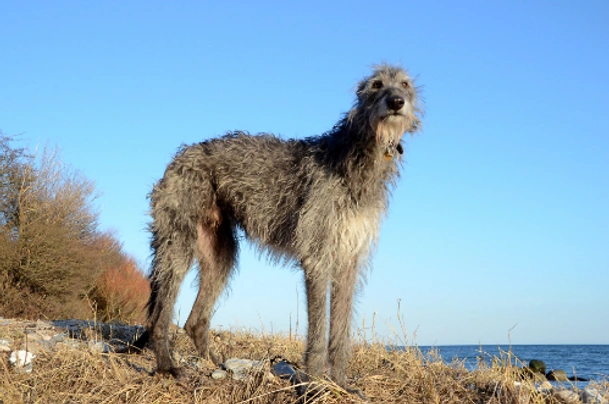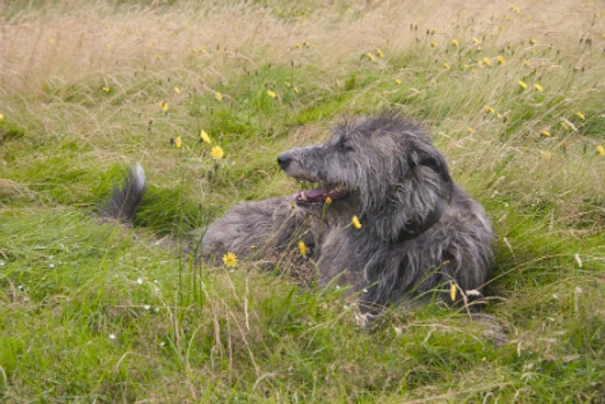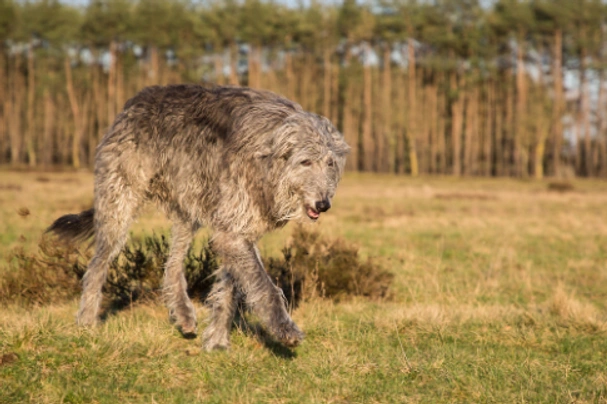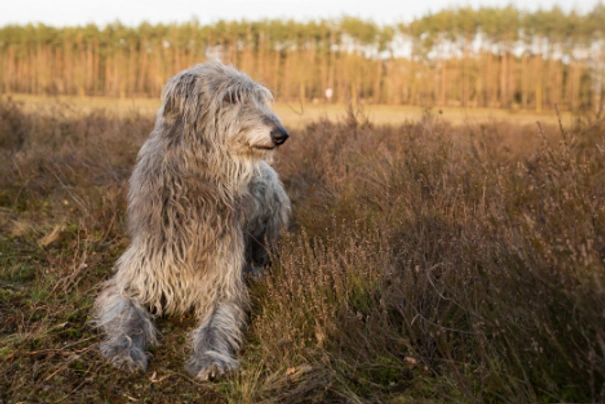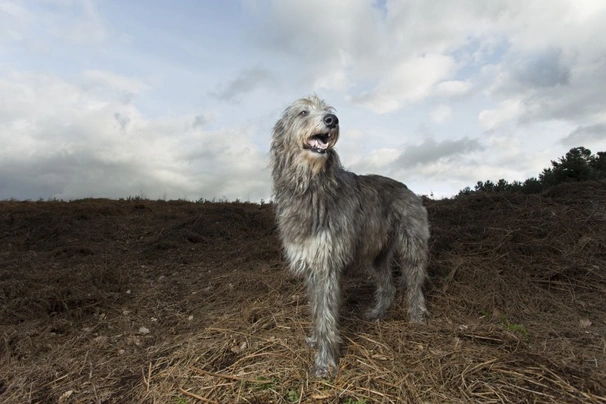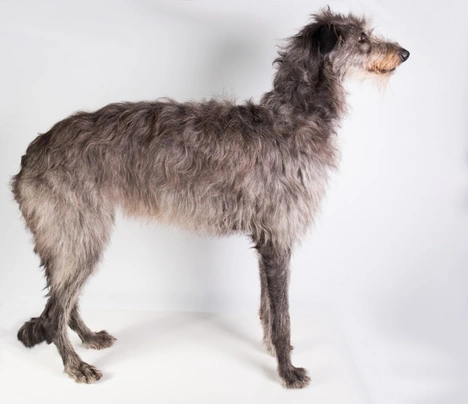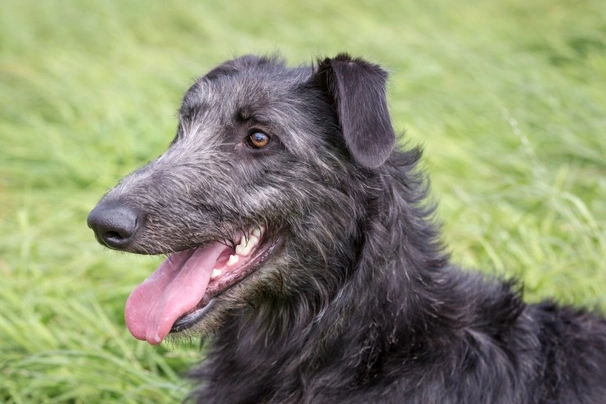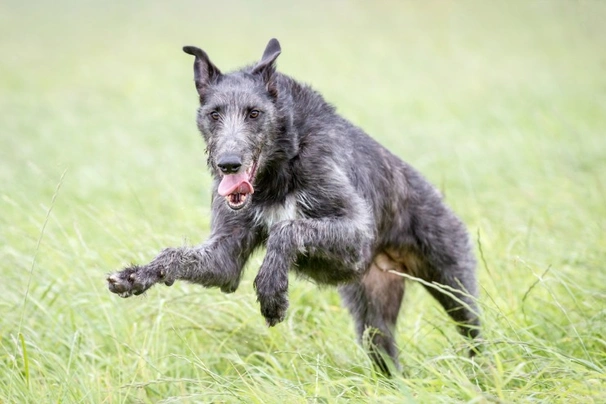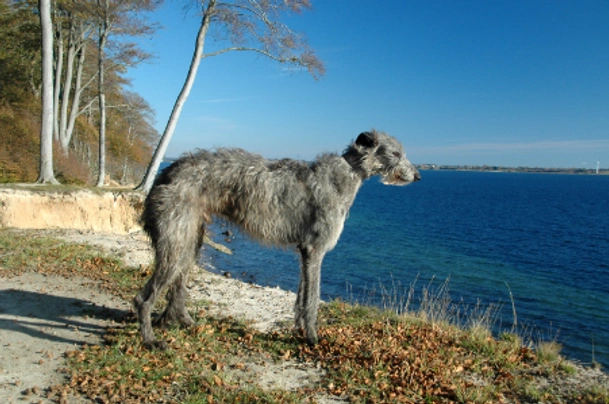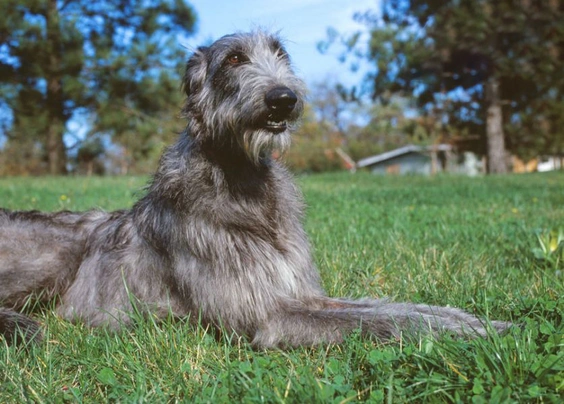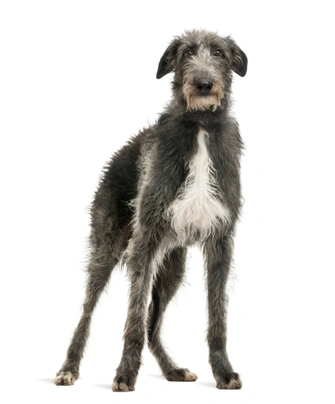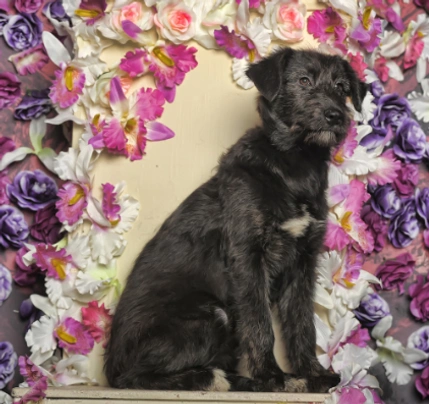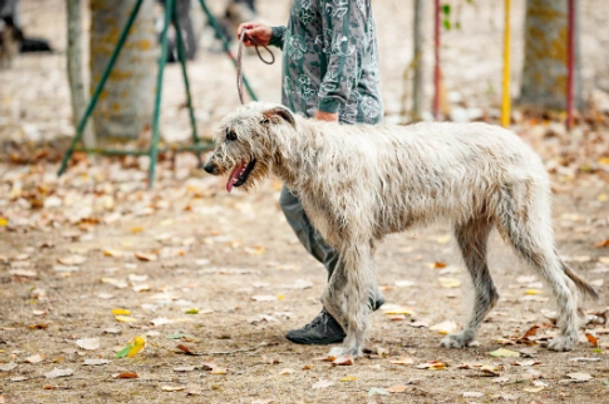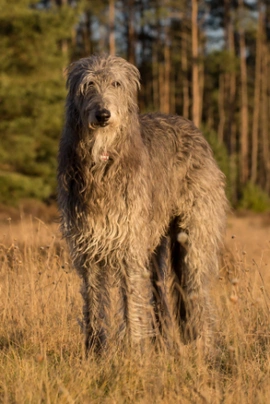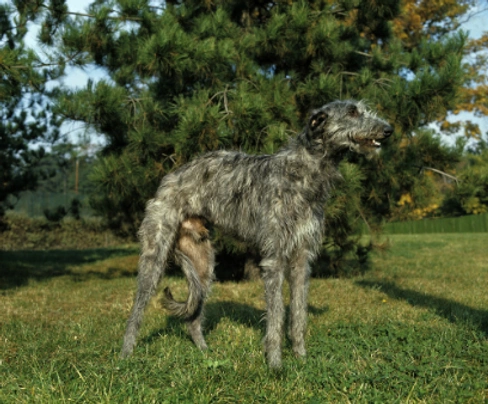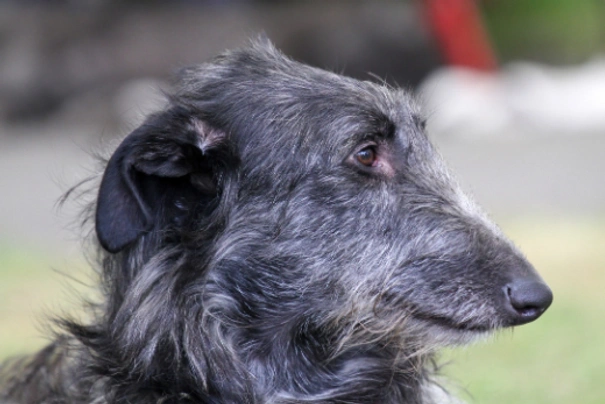Deerhound
Pros
Cons
Introduction of the Deerhound
The Deerhound is a large harsh coated breed that is often described as being tall graceful and very hairy. They are related to the Greyhound and originate from north of the border where they were often referred to as the 'Royal Dog of Scotland' because at one point in history only royals and nobles were allowed own them. Sadly the breed is currently one of the UK's native dogs that has been placed on the Kennel Club’s vulnerable list.
Deerhounds are magnificent characters ideally suited to life in the country and they are renowned for being wonderful family pets. However because of their large size sharing a home with a Deerhound is on the expensive side not only on the food front but pet insurance premiums tend to be on the high side too. With this said anyone who leads an active outdoor life and who is familiar with the needs of a large dog would not go far wrong in choosing to do so with a Deerhound.
History of the Deerhound
Dogs very like Greyhounds and they have been around since the 3rd Century and throughout time they were worked alongside hunters. However it was in the 15th Century that references were made of many hound breeds which includes English Greyhounds Irish Wolfhounds and Highland Deerhounds with images being recorded too. These records show that certain breeds with the same lineage in their lines were being developed in various regions of the land. Over time this resulted in several very similar looking hound-type breeds being created.
There are also records that their ancestors are breeds like Rough Greyhounds Scotch Greyhounds Scottish Deerhounds Highland Deerhounds and Irish Greyhounds all of which were introduced into the mix. With this said there are no records of when exactly the breed was called a "Deerhound". It is also worth noting that at one time which included prior to the middle of the 18th Century there were many varieties of “hounds” with two lines becoming more prominent than others known as the Lowland and the Highland. The latter being the taller and stronger with heavier harsher coats than the Lowland. These Deerhounds were bred to course deer alongside hunters but as time passed and guns were introduced into the hunting scene they started working alongside guns too.
By the beginning of the 19th Century breed numbers fell dangerously low when larger Scottish estates were divided into smaller ones. It was a time when the number of Deerhound kept on estates for hunting purposes were drastically reduced thanks to the new hunting trend of "stalking and shooting". This form of hunting meant that the only dogs needed were to track a wounded animal. As such other breeds with excellent scenting abilities were deemed for suitable for the job than the Deerhound.
With this said larger estates still kept Deerhounds and this included Queen Victoria who owned a pack of Deerhounds on her estate. But it was not until the mid-1830's that the breed became popular again with two brothers by the name of Archibald and Duncan McNeill saving the breed in the 1800s when they started a breeding programme. During World War II like many breeds once again the number of dogs declined. It was very difficult to feed the large dogs and many were destroyed.
Thanks to the efforts and endeavours of breed enthusiasts the Deerhound did not vanish altogether although the gene pool was very small. As such breeders introduced other dogs with an end goal being to improve vigour and size. Sir Walter Scott owned a now famous male Deerhound called "Maida" a dog that was produced by crossing a Deerhound bitch with a Pyrenean. Bloodhounds were also introduced into the mix which helped improve a Deerhound's scenting skills. The Borzoi too was used with an end goal being to improve a dog's conformation and elegance. In 1886 the Deerhound Club was founded and a breed standard was established a few years later in 1892. This was later amended in 1948 a standard which remains the same today.
With the advent of dog shows more enthusiasts became aware of the Deerhound which went a long way in improving and stabilising the breed. Today the Deerhound is still very rarely seen both here in the UK and elsewhere in the world with their numbers remaining low. As such these beautiful dogs have been placed on the native breed vulnerable list by The Kennel Club and anyone wanting to share a home with one would need to register their interest with breeders and go on a list for the pleasure of doing so.
Interesting facts about the breed
- Is the Deerhound a vulnerable breed? Yes they have been placed on the native vulnerable breed list although their numbers are increasing albeit slowly
- Walter Scott owned a now famous Deerhound called "Maida"
- The oldest know line is thought to be the "Chesthill"
- Captain Graham drew up records of pedigree Deerhounds at the end of the 19th Century
- Queen Victoria owned a pack of Deerhounds on her country estate
- Breed numbers fell dangerously low during the Second World War
Appearance of the Deerhound
Height at the withers: Males 76 cm Females 71 cm
Average weight: Males 45.5 kg Females 36.5 kg
A Deerhound is a very large yet extremely elegant dog that boasts a long rough coat very reminiscent of that of a rough coated Greyhound. These hounds may be very large but they are gentle giants and have lovely large heads which are especially broad at a dog's ears. Their muzzles taper to their nose and dogs have nice level lips. Their heads are long with the top of it being rather flat with dogs having a slight rise over their eyes rather than a stop and are covered in longish hair which is a lot softer than on the rest of their bodies. Noses are black in colour and slightly aquiline in shape. Dogs have a nice moustache made up of silky hair and they also have a slight beard.
A Deerhound's eyes are quite full and dark in colour which can either be hazel or dark brown. These dogs always have soft look in their eyes when they are relaxed but when alert this changes to a very keen expression. Their ears are set high and when relaxed a dog holds them folded back. When excited or alert they hold their ears raised but the fold remains. Ears are covered in glossy hair and they are soft to the touch. They can be either a dark colour or black. The Deerhound has a strong jaw with a perfect scissor bite where their upper teeth neatly overlap their lower ones.
Necks are extremely strong with dogs boasting a long reach although this can often be hidden by a dog's mane. Their nape is quite prominent but there is no throatiness around their necks. Shoulders are well laid back and set not too far apart. Front legs are straight and broad. A Deerhound's body is very much like that of a Greyhound only a lot larger and with a lot more bone. Their chest is deep and loins are well arched before dropping down to a dog's tail.
Hindquarters are broad and fall away with dogs boasting powerful with hips that are set well apart. Back legs are well bent at the stifle. Their feet are compact being well knuckled and Deerhounds boast having very strong nails. Tails are long and thicker at the root before they taper to the tip. Dogs carry their tails straight down or slightly curved when relaxed but when alert or moving they carry them curved higher. Tails are well covered in hair on the upper side it is wiry and thick while underneath the hair is longer.
When it comes to their coat the Deerhound boasts a shaggy thick close-lying coat that's rather ragged in appearance and crisp to the touch. The hair on a dog's body their neck and their quarters is wiry and harsh whereas on their heads breasts and bellies the hair is a lot softer to the touch. Deerhounds have a slightly hairy fringe on the inside of their front and back legs. Accepted breed colours for Kennel Club registration are as follows:
- Black & Grey
- Blue Brindle
- Blue Grey
- Brindle
- Dark Brindle
- Dark Grey
- Grey
- Grey Brindle
Gait/movement
When a Deerhound moves they do so with an elegant easy gait taking long strides and covering a lot of ground when they do.
Faults
The Kennel Club frowns on any exaggerations or departures from the breed standard and would judge the faults on how much they affect a dog's overall health and wellbeing as well as their ability to perform. Woolly coats are also considered to be a fault in the breed.
Males should have both testicles fully descended into their scrotums and it is worth noting that a dog can be a little lighter or heavier as well as slightly taller or shorter than set out in the Kennel Club breed standard which is only given as a guideline.
Temperament of the Deerhound
Deerhounds are renowned for being "gentle giants" although playtime can be boisterous when they are young. They are naturally quiet dignified and gentle dogs that boast a friendly and laid-back approach to life. They are among the breeds that seem to have an affinity with children and there is nothing they like more than to be in a loving family environment. Given their large size they can tend to be clumsy especially when they are still youngsters. They are not the best choice for first time owners simply because they need to be with people who have a deep understanding of the breed and what it takes to look after and care for such a large hound.
They are however a great choice for people who are familiar with this type of dog who live in the country and who would be able to dedicate the time it takes to exercise and look after them. They are known to be intelligent and they are always eager and willing to please but their socialisation training and education must start early for them to mature into well-rounded and obedient dogs.
Like so many other hound breeds the Deerhound is a sensitive character by nature and as such they do not respond well to any sort of harsh correction or heavy-handed training methods. With this said they answer very well to positive reinforcement which should involve them being trained with a firm fair and gentle hand.
Are they a good choice for first time owners?
Deerhounds are not the best choice for first time dog owners because they are better suited to people who are familiar with the specific needs when it comes to care feeding costs and veterinary bills associated with large sighthounds.
What about prey drive?
Being sighthounds the Deerhound is quick off the mark to chase anything they spot in the distance. As such care should always be taken as to where and when a dog can run off the lead more especially when wildlife and livestock is close by.
What about playfulness?
Deerhounds although placid and quiet by nature love to play and will happily keep an owner entertained when they mood takes them. They adore being out and about although they are renowned for being quite lazy if allowed and will happily lay on a comfy sofa for hours on end.
What about adaptability?
Deerhounds are better suited to people who are not only familiar with their specific needs but also who have large ultra-secure back gardens a dog can safely roam around in whenever possible. As such being such a large breed they would not be happy living in an apartment in town.
What about separation anxiety?
Although Deerhounds form strong bonds with their families they don't mind being left on their own providing it is never for too long which could result in them developing a few unwanted behavioural issues. With this said in general they are not known to suffer from separation anxiety and will happily curl up on a sofa when there is no one at home.
What about excessive barking?
Most Deerhounds are not known to be "barkers" and have a very unique voice all of their own. They will howl when the mood takes them which could be when left on their own for extended periods of time.
Do Deerhounds like water?
Most Deerhounds like swimming and will take to the water whenever they can more especially when the weather is hot or to retrieve a favourite ball. However if anyone who owns a dog that does not like water should never force them to go in because it would just end up scaring them. With this said care should always be taken when walking a Deerhound off the lead anywhere near more dangerous watercourses just in case a dog decides to leap in and then needs rescuing because they cannot get out of the water on their own.
Are Deerhounds good watchdogs?
Deerhounds are not natural watchdogs although this is not to say they would let an owner know when there is someone at the door. Like a lot of other sighthounds they prefer to keep their distance when around people they don't know but rarely would a Deerhound show any sort of aggressive behaviour to strangers.
Intelligence / Trainability of the Deerhound
In the right hands Deerhounds are quick to learn new things and will always try to do what is asked of them. They are intelligent obedient characters that like to please. However early socialisation is a must with these large dogs which means introducing them to as many new situations people animals and other dogs as soon as they have been fully vaccinated. As previously touched upon their training must start early it must be consistent and always fair throughout their lives because Deerhounds are never happier than when they know who they can look to for guidance and direction.
Like all puppies Deerhound puppies are incredibly cute and it is all too easy to spoil them when they first arrive in their new homes. However these cute puppies quickly grow up to be large impressive sighthounds and as such owners must start out as they mean to go on. This means that as soon as a puppy is settled into a new home they are given rules and boundaries which help when it comes to understanding what is expected of them. It also helps establish a "pecking" order and who is the alpha dog in a household. It is also a good idea to teach a Deerhound puppy to play outside to avoid too many breakages around the home. With this said the first commands a Deerhound puppy should be taught are as follows:
- Come
- Sit
- Stay
- Heel
- Quiet
- Leave it
- Down
- Bed
Children and other
Despite their large size the Deerhound is known to be a real gentle giant and this includes when they are around children. With this said they may well accidentally knock a child over because they are known to be a little clumsy which is especially true when they are going through the adolescent stage of their lives. As such any interaction between toddlers and these large dogs must be supervised by an adult to make sure playtime does not get too boisterous which could end up with someone getting hurt or frightened.
With early socialisation Deerhounds can live with other dogs even given their hunting heritage but caution should always be observed if they are to live with smaller pets especially cats because their instincts might get the better of them with disastrous results.
Health of the Deerhound
The average life expectancy of a Deerhound is between 8 and 9 years when properly cared for and fed an appropriate good quality diet to suit their ages.
The Deerhound is known to known to be a healthy breed and one that does not appear to suffer from the many hereditary and congenital disorders that seem to plague other pure breeds. The conditions that seem to affect the breed the most include the following:
- Portosystemic shunt (congenital) - puppies must be tested before being sold
- Factor VII Deficiency - parent dogs must be DNA tested
- Von Willebrand’s Disease (vWD) Type 1 - dogs should be tested
- Craniomandibular Osteopathy (CMO) - dogs should be tested
- Osteosarcoma (bone cancers)
- Urolithiasis
- Heart problems
- Bloat/gastric torsion
What about genetic diversity?
Because the breed’s gene pool is not as big as in some other breeds it is extremely important for breeders to take extra care when choosing stud dogs. The coefficient for Deerhounds is 12.7% and as a result when it comes inbreeding there is a reasonable degree as to how much this happens. With this said breeders are advised to keep inbreeding coefficient as low as possible in their bloodlines.
What about conformation problems?
Being tall and leggy with deep narrow chests a Deerhound's conformation predisposes them to suffering from gastric torsion (bloat) which can prove fatal if not recognised and treated as a matter of urgency.
What about vaccinations?
Deerhound puppies would have been given their initial vaccinations before being sold but it is up to their new owners to make sure they have their follow-up shots in a timely manner with the vaccination schedule for puppies being as follows:
- 10 -12 weeks old bearing in mind that a puppy would not have full protection straight away but would be fully protected 2 weeks after they have had their second vaccination
There has been a lot of discussion about the need for dogs to have boosters. As such it's best to talk to a vet before making a final decision on whether a dog should continue to have annual vaccinations which are known as boosters.
What about spaying and neutering?
A lot of vets these days recommend waiting until dogs are slightly older before spaying and neutering them which means they are more mature before undergoing the procedures. As such they advise neutering males and spaying females when they are between the ages of 6 to 9 months old and sometimes even when a dog is 12 months old.
Other vets recommend spaying and neutering dogs when they are 6 months old but never any earlier unless for medical reasons. With this said many breeds are different and it is always advisable to discuss things with a vet and then follow their advice on when a dog should be spayed or neutered.
What about obesity problems?
Deerhounds have an athletic build but they are known to be lazy and will happily turn into couch potatoes when allowed to. As such it's important to keep an eye on their weight. Dogs can also gain weight after they have been spayed or neutered. If a dog starts to put on weight it's important to adjust their daily calorie intake and to up the amount of exercise they are given. Older dogs too are more prone to gaining weight and again it's essential they be fed and exercised accordingly because obesity can shorten a dog's life by several years. The reason being that it puts a lot of extra strain on a dog's internal organs including the heart which could prove fatal bearing in mind that Deerhounds have shorter lifespans than many other breeds anyway.
What about allergies?
Some Deerhounds are prone to suffering from allergies and it's important for a dog to see a vet sooner rather than later if one flares up. It's important to thoroughly dry off a dog's coat when they've been in the water too. Allergies can be notoriously hard to clear up and finding the triggers can be challenging. With this said a vet would be able to make a dog with an allergy more comfortable while they try to find out the triggers which could include the following:
- Certain dog foods that contain high levels of grain and other cereal-type fillers
- Airborne pollens
- Dust mites
- Environment
- Flea and tick bites
- Chemicals found in everyday household cleaning products
Participating in health schemes
All responsible Deerhound breeders would ensure that their stud dogs are tested for known hereditary and congenital health issues known to affect the breed by using the following schemes:
- Puppies screened for liver shunt before being sold
- DNA test for parent dogs for Factor VII deficiency
- Von Willebrand’s Disease (vWD) Type 1 - dogs should be tested
- Craniomandibular Osteopathy (CMO) - dogs should be tested
What about breed specific breeding restrictions?
Apart from the standard breeding restrictions on all Kennel Club registered breeds there are no other breed specific breeding restrictions in place for the Deerhound.
What about Assured Breeder Requirements?
The Kennel Club strongly recommends that all breeders whether KC Assured on not should tests all Deerhound puppies before being sold for the following health issue:
- Liver shunt
Caring for the Deerhound
As with any other breed Deerhounds need to be groomed on a regular basis to make sure their coats and skin are kept in top condition. They also need to be given regular daily exercise to ensure they remain fit and healthy. On top of this dogs need to be fed good quality food that meets all their nutritional needs throughout their lives.
Caring for a Deerhound puppy
Deerhound puppies are boisterous and full of life which means it's essential for homes and gardens to be puppy-proofed well in advance of their arrival. A responsible breeder would have well socialised their puppies which always leads to more outgoing confident and friendly dogs right from the word go. With this said any puppy is going to feel vulnerable when they leave their mother and littermates which must be taken into account. The longer a puppy can remain with their mother the better although it should never be for too long either.
It's best to pick a puppy up when people are going to be around for the first week or so which is the time needed for a puppy to settle in. Puppy-proofing the home and garden means putting away any tools and other implements that a boisterous puppy might injure themselves on. Electric wires and cables must be put out of their reach because puppies love chewing on things. Toxic plants should be removed from flowerbeds and the home too.
Puppies need to sleep a lot to grow and develop as they should which means setting up a quiet area that's not too out of the way means they can retreat to it when they want to nap and it's important not to disturb them when they are sleeping. It's also a good idea to keep "playtime" nice and calm inside the house and to have a more active "playtime" outside in the garden which means puppies quickly learn to be less boisterous when they are inside.
The documentation a breeder provides for a puppy must have all the details of their worming date and the product used as well as the information relating to their microchip. It is essential for puppies to be wormed again keeping to a schedule which is as follows:
- Puppies should be wormed at 6 months old
- They need to be wormed again when they are 8 months old
- Puppies should be wormed when they are 10 months old
- They need to be wormed when they are 12 months old
Things you'll need for your puppy
There are certain items that new owners need to already have in the home prior to bringing a new puppy home. It's often a good idea to restrict how much space a puppy plays in more especially when you can't keep an eye on what they get up to bearing in mind that puppies are often quite boisterous which means investing in puppy gates or a large enough playpen that allows a puppy the room to express themselves while keeping them safe too. The items needed are therefore as follows:
- Good quality puppy or baby gates to fit on doors
- A good well-made playpen that's large enough for a puppy to play in so they can really express themselves as puppies like to do
- Lots of well-made toys which must include good quality chews suitable for puppies to gnaw on bearing in mind that a puppy will start teething anything from when they are 3 to 8 months old
- Good quality feed and water bowls which ideally should be ceramic rather than plastic or metal
- A grooming glove
- A slicker brush or soft bristle brush
- Dog specific toothpaste and a toothbrush
- Scissors with rounded ends
- Nail clippers
- Puppy shampoo and conditioner which must be specifically formulated for use on dogs
- A well-made dog collar or harness
- A couple of strong dog leads
- A well-made dog bed that's not too small or too big
- A well-made dog crate for use in the car and in the home that's large enough for a puppy to move around in
- Baby blankets to put in your puppy's crate and in their beds for when they want to nap or go to sleep at night
Keeping the noise down
All puppies are sensitive to noise including Deerhound puppies bearing in mind that like all sighthounds they are ultra-sensitive by nature to any sort of loud sounds including raised voices. It's important to keep the noise levels down when a new puppy arrives in the home. TVs and music should not be played too loud which could end up stressing a small puppy out and which could result in them being timid and shy.
Keeping vet appointments
As previously mentioned Deerhound puppies would have been given their first vaccinations by the breeders but they must have their follow up shots which is up to their new owners to organise. The vaccination schedule for puppies is as follows:
- 10 -12 weeks old bearing in mind that a puppy would not have full protection straight away but would only be fully protected 2 weeks after they have had their second vaccination
When it comes to boosters it's best to discuss these with a vet because there is a lot of debate about whether a dog really needs them after a certain time. However if a dog ever needed to go into kennels their vaccinations would need to be fully up to date.
What about older Deerhounds when they reach their senior years?
Older Deerhounds need lots of special care because as they reach their golden years they are more at risk of developing certain health concerns. Physically a dog's muzzle may start to go grey but there will be other noticeable changes too which includes the following:
- Coats become coarser
- A loss of muscle tone
- Deerhounds can either become overweight or underweight
- They have reduced strength and stamina
- Older dogs have difficulty regulating their body temperature
- They often develop arthritis
- Immune systems do not work as efficiently as they once did which means dogs are more susceptible to infections
Older dogs change mentally too which means their response time tends to be slower as such they develop the following:
- They respond less to external stimuli due to impaired vision or hearing
- They tend to be a little pickier about their food
- They have a lower pain threshold
- Become intolerant of any change
- Often an older dog can feel disorientated
Living with a Deerhound in their golden years means taking on a few more responsibilities but these are easily managed and should include taking a look at their diet the amount of exercise they are given how often their dog beds need changing and keeping an eye on the condition of their teeth.
Older Deerhounds need to be fed a good quality diet that meets their needs at this stage of their lives all the while keeping a close eye on a dog's weight. A rough feeding guide for older dogs is as follows bearing in mind they should be fed highly digestible food that does not contain any additives:
- Protein content should be anything from 14 – 21%
- Fat content should be less than 10%
- Fibre content should be less than 4%
- Calcium content should be 0.5 – 0.8%
- Phosphorous content should be 0.4 – 0.7%
- Sodium content should be 0.2 – 0.4%
Older Deerhounds don't need to be given the same amount of daily exercise as a younger dog but they still need the right amount of physical activity to maintain muscle tone and to prevent a dog from putting on too much weight. All dogs need access to fresh clean water and this is especially true of older dogs when they reach their golden years because they are more at risk of developing kidney disorders.
Grooming of the Deerhound
The Deerhound's coat is harsh and wiry which means it needs to be brushed on a regular basis to prevent any matts or tangles from forming. They do not which means their coats should also be hand stripped at least twice a year and this is best left up to a professional groomer.
It's also important to check a dog's ears on a regular basis and to clean them when necessary. If too much wax builds up in a dog's ears it can lead to a painful infection which can be hard to clear up. In short prevention is often easier than cure when it comes to ear infections.
Exercise of the Deerhound
Deerhounds need to be given a ton of daily exercise and ideally this should be a minimum of 2 hours. A shorter walk in the morning would be okay but a much longer and more interesting one in the afternoon is a must to keep these dogs happy and healthy. They also benefit from being allowed to roam around a back garden as often as they can but the fencing must be very secure to keep these dogs in. However they are definitely not the sort of dog that would adapt well to life in the city whereas they thrive in a country environment.
With this said young Deerhound puppies should not be given too much exercise because their joints and bones are still growing and too much pressure on them could result in causing a dog a few problems later in their lives. They should not be allowed to jump up or off furniture nor should they be allowed to run up and down the stairs because this puts too much pressure on their still growing joints and limbs.
Feeding of the Deerhound
If you get a Deerhound puppy from a breeder they would give you a feeding schedule and it's important to stick to the same routine feeding the same puppy food to avoid any tummy upsets. You can change a puppy's diet but this needs to be done very gradually always making sure they don't develop any digestive upsets and if they do it's best to put them back on their original diet and to discuss things with the vet before attempting to change it again.
Older dogs are not known to be fussy or finicky eaters but this does not mean you can feed them a lower quality diet. It's best to feed a mature dog twice a day once in the morning and then again in the evening making sure it's good quality food that meets all their nutritional requirements. It's also important that dogs be given the right amount of exercise so they burn off any excess calories or they might gain too much weight which can lead to all sorts of health issues. Obesity can shorten a dog's life by several years so it's important to keep an eye on their waistline from the word go.
Because Deerhounds are prone to suffer from bloat it is important that they be fed twice a day instead of giving them just one larger meal a day. It's also a good idea to invest in a stand to place their feed bowl which makes it easier for these large dogs to eat comfortably without having to stretch their necks down low to reach their food. You should never exercise a Deerhound just before or just after they have eaten either because this puts them more a risk of suffering from bloat.
Feeding guide for a Deerhound puppy
Puppies need to be fed a highly nutritious good quality diet for them to develop and grow as they should. As a rough guide a Deerhound puppy can be fed the following amounts every day making sure their meals are evenly spread out throughout the day and it's best to feed them 3 or 4 times a day:
- 2 months old - 289g to 359g depending on puppy's build
- 3 months old - 386g to 510g depending on puppy's build
- 4 months old - 429g to 577g depending on puppy's build
- 5 months old - 514g to 701g depending on puppy's build
- 6 months old - 587g to 809g depending on puppy's build
- 7 months old - 589g to 822g depending on puppy's build
- 8 months old - 585g to 824g depending on puppy's build
- 9 months old - 537g to 808g depending on puppy's build
- 10 months old - 501g to 758g depending on puppy's build
- 11 months old - 456g to 704g depending on puppy's build
- 12 months old - 414g to 651g depending on puppy's build
- 13 months old - 411g to 607g depending on puppy's build
- 14 months old - 406g to 566g depending on puppy's build
Once a puppy is 24 months old they can be fed adult dog food.
Feeding guide for an adult Deerhound
Once fully mature an adult Deerhound should be fed a good quality diet to ensure their continued good health. As a rough guide an adult dog can be fed the following amounts every day making sure to spread out a dog's meals and not to feed them just before going out for a walk or just when they get back to prevent them from suffering from bloat:
- Dogs weighing 36.5 kg can be fed g to g depending on activity
- Dogs weighing 45.5 kg can be fed g to g depending on activity
Deerhound price
If you are looking to buy a Deerhound you may have to go on a waiting list because not many puppies are registered with The Kennel Club every year and you would need to pay upwards of £1000 for a well-bred pedigree puppy. The cost of insuring a male 3-year-old Deerhound in northern England would be £74.21 a month for basic cover but for a lifetime policy this would set you back £133.98 a month (quote as of February 2018). When insurance companies calculate a pet's premium they factor in several things which includes where you live in the UK and a dog's age and whether they have been neutered or spayed.
When it comes to food costs you need to buy the best quality food whether wet or dry to feed your dog throughout their lives making sure it suits the different stages of their lives. This would set you back between £60 - £70 a month. On top of this you would need to factor in veterinary costs if you want to share your home with a Deerhound and this includes their initial vaccinations their annual boosters the cost of neutering or spaying your dog when the time is right and their yearly health checks all of which quickly adds up to over a £2000 a year.
As a rough guide the average cost to keep and care for a Deerhound would be between £140 to £210 a month depending on the level of insurance cover you opt to buy for your dog but this does not include the initial cost of buying a pedigree puppy.
Buying advice
When visiting and buying any puppy or dog there are many important things to consider and questions to ask of the breeder/seller. You can read our generic puppy/dog advice here which includes making sure you see the puppy with its mother and to verify that the dog has been wormed and microchipped.
Although rare Deerhounds have a large fanbase and healthy well-bred puppies can command a lot of money. As such with Deerhounds there is specific advice questions and protocols to follow when buying a puppy which are as follows:
- Beware of online scams and how to avoid them. You may see online and other adverts by scammers showing images of beautiful Deerhoundpuppies for sale at very low prices. However the sellers ask buyers for money up front before agreeing to deliver a puppy to a new home. Potential buyers should never buy a puppy unseen and should never pay a deposit or any other money online to a seller. You should always visit the pet at the sellers home to confirm they are genuine and make a note of their address.
- As previously touched upon Deerhounds have a large fanbase in the UK. As such there are many amateur breeders/people who breed from a dam far too often so they can make a quick profit without caring for the welfare of the puppies their dam or the breed in general. Under Kennel Club rules a dam can only produce 4 litters and she must be between a certain age to do so. Anyone wishing to buy a Deerhound puppy should think very carefully about who they purchase their puppy from and should always ask to see the relevant paperwork pertaining to a puppy's lineage their vaccinations and their microchipping.
- Prospective owners should be very careful when considering buying a Deerhound puppy with a woolly coat which is not the correct type of coat for the breed which should be shaggy without every being overcoated.

Scottish Deerhound Puppies
£1,500
